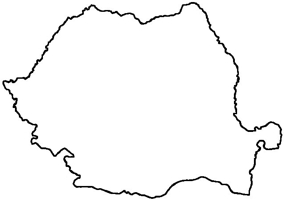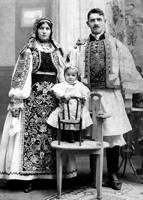
|
The Society of Folk Dance Historians (SFDH)
Choreogeography:
[
Home |
About |
Encyclopedia | CLICK AN IMAGE TO ENLARGE |

|
 The former Roman colony of Dacia got its present name, Romania, because of its ties to the Empire. Romanian is a Romance language surrounded by Slavic and Hungarian languages and is more related to Italian than any of its neighbors.
The former Roman colony of Dacia got its present name, Romania, because of its ties to the Empire. Romanian is a Romance language surrounded by Slavic and Hungarian languages and is more related to Italian than any of its neighbors.
For hundreds of years following Rome's demise, the regions now known as Wallachia and Moldavia became migration routes for the Goths, the Huns, the Slavs, and the Magyars. By the end of the 13th Century, the two regions had established an identity and suffered the role of a buffer state between the Magyar and Turkish empires. Wallachian prince Michael the Brave managed to unite the two states with Transylvania during the 16th Century, but the union disappeared on his assassination in 1601. That union was the reason for the return of Transylvania to Romania after World War I.
In 1859, after some 250 years of intrigue and imposition by Turkey, Russia and Greece, Wallachia and Moldavia were united under Prince Alexandru Ion Cuza. Though torn by political turmoil and not recognized as a sovereign state until 1878, this was the beginning of the modern Romanian state.
The new country occupied the north plain of the Danube River valley and the western edge of the Black Sea, bounded on the northwest by the Carpathian Mountains, to which people fled frequently during foreign invasions.
In 1919, Transylvania was granted to Romania by the Treaty of Trianon, taken from the Austro-Hungarian Empire. After World War II, the Soviets seized Bessarabia and Bukovina, on the north side of Moldavia.
Thus, Romania is divided into clearly defined regions: The Pontic Plain along the Black Sea, the Danube Valley along the southern border with Bulgaria, the eastern Pannonian Plain of Banat, and the highlands of Transylvania. Each region has its own folklore and culture and the state of Romania has one of the richest folklore traditions in Europe. Its music and dance have attracted the attention of artists and folklorists from around the world and Romanian artists are world-reknown.
 Transylvania is particularly rich in dance and folklore. Its name ("across the forests") comes from the migration routes of the 10th Century Magyars who crossed over the Carpathian Mountains from the Danube Valley to settle in the Hungarian Basin. The region's population is a mixture of Romanian and Hungarian people; the German "Saxons" were removed following World War II.
Transylvania is particularly rich in dance and folklore. Its name ("across the forests") comes from the migration routes of the 10th Century Magyars who crossed over the Carpathian Mountains from the Danube Valley to settle in the Hungarian Basin. The region's population is a mixture of Romanian and Hungarian people; the German "Saxons" were removed following World War II.
Transylvanian dance is brilliant and challenging, displaying remarkable dexterity and agility. Men's dances are vigorous and rich in figures, with complex boot slapping rhythms and athletic leg gestures. Hungarian Transylvanian dances tend to be competitive; Romanian versions are usually performed in unison. Couple dances abound, a sure indication of Renaissance influence, characterized by the men spinning women in complex figures.
Wallachia (Muntenia) dance shows the influence of the Ottoman Turks and the Bulgarians across the Danube River in a culture shared with the people of northern Bulgaria: few if any couple dances, but countless line dances characterized by dazzling footwork, complex rhythms, and very rapid tempos.
Moldavia has a charming and unique dance style all its own. A strong mixture of couple and line dances shows the influence of the Turks to the south and the Europeans from the north. An interesting upper body movement, tilting from the waist to one side or the other, is observed in many dances and the music is as infectious as any to be found anywhere.
Banat lies on the eastern plain, in the midst of powerful neighbors: Serbs, Bulgarians, Hungarians, and Romanians. This has created a rich dance culture with strong influences from each.
The Căluş is one of those cultural relics so dear to ethnologists and historians. The dance and its performers, the "căluşarii," are one of Romania's most well-known symbols. Originating in pre-Christian rituals, the dance is typical of fertility dances found throughout Europe. Groups of male dancers wielding phallic symbols of one form or another (wooden swords, decorated staffs, etc.) perform complex dances at the time of spring planting to ensure fertility of the crops and a good harvest.
The căluşari are a society within the community, preserving and passing the dance from one generation to another. Very young boys can be found performing the complex dance figures with great skill.
The dancers are festooned with bells, fringe, and tassles that serve to enhance the dancers' movements. Light leather footwear permit very rapid footwork and great agility, a characteristic of the dance. The staff is decorated with ribbons and bells and is used extensively in the dance to gesture and to support the dancer.
The dancers, in their small group, walk from house to house through the village, stopping at each house in turn to perform the dance. They are then rewarded with gifts of food and drink by the homes' inhabitants to ensure the success of the dance's influence on the crops.
Romanian music is one of the most melodic of any in Europe, featuring elaborate embellishments on violin, panpipe, and cymbol (hammer dulcimer). Inescu's Romanian Rhapsodies are among the most recognized and beloved melodies in Western music and are based heavily on Romanian folk melodies.
Romanian embroidery is one of the most well-known and cherished among American recreational folk dancers. Any gathering of dancers reveals numerous one-of-a-kind folk blouses, sleeves and shoulders covered with traditional Romanian folk embroidery. The study of Romanian folk costume rewards one with treasures of unmatched weavings and embellishments using beading, embroidery, and fine needlework equal to any on earth.
Those of us who study and love the dance and music of Romania are indeed fortunate, for we share in one of the world's richest folk cultures.
DOCUMENTS
- Richard Duree, an article.
- Romania, a country.
- Transylvania, a region.
Used with permission of the author.
This page © 2018 by Ron Houston.
Please do not copy any part of this page without including this copyright notice.
Please do not copy small portions out of context.
Please do not copy large portions without permission from Ron Houston.